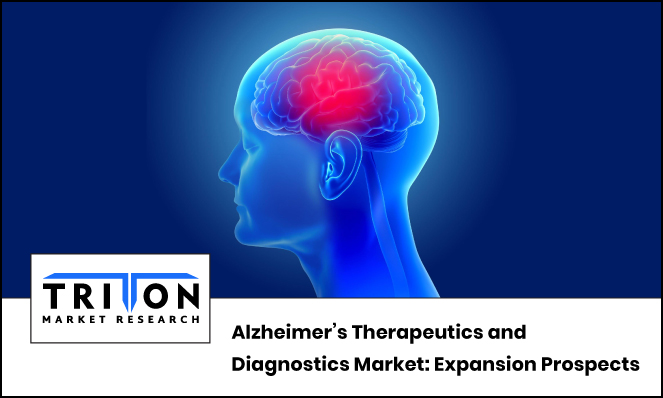



12, August 2022

According to estimates, nearly 5.8 million individuals in the United States were reported to have Alzheimer’s disease (AD) in 2020; and by 2050, this number is expected to surge to 13.8 million individuals. The rising prevalence of this disease across the globe emphasizes the pressing need to develop effective diagnostic methodologies and treatments.
Triton Market Research puts forth that the Global Alzheimer’s Disease Therapeutics and Diagnostics Market is likely to grow with a CAGR of 6.98% in the forecasting period from 2022 to 2028.
Alzheimer’s is a neurodegenerative disease that attacks the neurons, gradually damaging a person’s memory, thinking skills, and ability to perform the simplest daily tasks. People in the age group of 65 years or older are more prone to this condition, as a result of aging. Thus, the rising elderly populace is a key factor driving the demand for AD therapeutics and diagnostics.
Computed Tomography leads the Diagnostics segment with a $339.50 million revenue in 2021.
The mortality rate from Alzheimer’s can be minimized if the disease is diagnosed and treated in the early stages. Computed Tomography (CT) is an advanced and cost-effective diagnostic procedure for AD. As per Medscape, the cost of a CT scan is nearly 20% less than that of an MRI scan. The benefits offered by this technique and its effectiveness in diagnosing AD are driving the overall segment’s growth.Blood Test is estimated to grow with the fastest CAGR in the Diagnostics segment, with a 20.93% CAGR during 2022-2028.
Blood testing for AD is an emerging technique that could help detect the disease prior to its onset or in those showing early symptoms. Several players are engaged in developing blood-based tests to identify Alzheimer’s disease biomarkers, as this approach is less invasive and more affordable than the currently available brain imaging and spinal fluid tests. Most of these pipelined products are awaiting marketing approval from the US Food and Drug Administration (FDA) and are most likely to be launched towards the end of the forecast period.
According to Alzheimer’s Drug Discovery Foundation, the pharmacological treatment for AD is first tested during clinical trials registered with ClinicalTrials.gov, a registry of publicly & privately funded clinical studies under the National Institutes of Health (NIH). In the US, any company that intends to manufacture a new drug, has to seek approval from the FDA, prior to conducting clinical trials. Similarly, in Japan, companies are required to seek approval from the regulatory body
The process is extremely cumbersome, as the manufacturers have to submit multiple applications for review before every phase of the trial. Also, post the successful completion of these trials, they must apply for licenses to market the drug. Such stringent regulations for drug development and commercialization are hampering the market’s growth.
There are several drugs in the pipeline for AD, aimed at cognitive enhancement or neuropsychiatric symptoms control. There are also certain pipeline drugs aimed at preventing, delaying, or slowing the progression of Alzheimer’s. The Alzheimer’s Association estimates that the disease’s prevalence can be reduced by 50% if its onset is delayed by five years. The association further states that, currently, there are 143 drugs in the pipeline for its treatment. In July 2021, Eli Lilly and Company collaborated with Banner Alzheimer’s Institute on the Phase 3 prevention trial for donanemab.
There is a high potential for developing a superior diagnosis for Alzheimer’s disease, compared to the diagnostic tests available at present. A research article published in Frontiers in Neurology (2020) states that newer techniques, which include the incorporation of PET neuroimaging and other genomics & proteomics biomarkers, are being adopted into revised diagnostic criteria.
Further, significant side effects of medicines and an unexpected lowered patient response towards treatment can be potential application areas for personalized therapy. It allows for a more accurate diagnosis and more effective treatment, with its patient-specific approach. Thus, the emergence of new diagnostic technologies and the development of personalized medicine indicate an overall positive outlook for the Alzheimer’s disease therapeutics and diagnostics market.

Prevalent cases of terrorist attacks in today’s world is increasing the need for severe standards of security for public safety, and the global market for biometric technology scrupulously accommoda..
Prevalent cases of terrorist attacks in today’s world is increasing the need for..